Greg's Top 51 Games of All Time, Installment 5 (10-1)
December 21, 2007 - Games
Well, here we are at the final list. My top ten games of all time. I'm sure this differs a lot from all the lists you'll see put out by gaming publications, but keep in mind this entirely excludes consoles I haven't owned and games I haven't played.
Let's recap the games I've already covered. Here's the recap.
- #51- Scorched Earth
- #50- Dungeons and Dragons: Tower of Doom
- #49- Dark Messiah of Might and Magic
- #48- Desktop Tower Defense
- #47- Wii Sports
- #46- Dragon Warrior IV
- #45- Puzzle Quest
- #44- Samurai Showdown
- #43- Dance Dance Revolution
- #42- Temple of Elemental Evil
- #41- Jade Empire
- #40- Maniac Mansion
- #39- Mechwarrior IV
- #38- Resident Evil
- #37- Double Dragon II
- #36- Adventure Construction Set
- #35- Castlevania III: Dracula's Curse
- #34- Mail Order Monsters
- #33- The Legend of Zelda: Phantom Hourglass
- #32- Fallout Tactics
- #31- Armored Core
- #30- Pool of Radiance
- #29- Kenseiden
- #28- Fallout 2
- #27- The Chronicles of Riddick: Escape from Butcher Bay
- #26- Dungeon Keeper
- #25- Autoduel
- #24- Far Cry
- #23- Shadows of the Colossus
- #22- Thief: Deadly Shadows
- #21- Point Blank
- #20- Fahrenheit (Indigo Prophecy)
- #19- Super Mario Galaxy
- #18- Tenchu: Stealth Assassins
- #17- Portal
- #16- Wasteland
- #15- Ultima V
- #14- Castlevania: Symphony of the Night
- #13- Resident Evil 2
- #12- Neverwinter Nights
- #11- Elder Scrolls IV: Oblivion
You can find details on each of the above games in my previous lists: 20 through 11, 30 through 21, 40 through 31, and 41 through 51. Read on for my top ten.
 #10: God of War (PS2) - God of War was 47th on IGN's list, but I'm placing it much higher on mine. Actually, I'd like to include both God of War and God of War II in the same entry here, as the sequel is essentially a continuation of the first game, perhaps with slightly higher quality.
#10: God of War (PS2) - God of War was 47th on IGN's list, but I'm placing it much higher on mine. Actually, I'd like to include both God of War and God of War II in the same entry here, as the sequel is essentially a continuation of the first game, perhaps with slightly higher quality.
The game's story is perhaps more than what you'd expect from a brawler like this, and the graphics are the best I've ever seen on the Playstation 2. I could go on to praise every last element of the game, but I'll stick to the parts that thrill me the most.
The fighting isn't easy, and without learning all the combos and special maneuvers Kraatos has available, you'll be hard-pressed to make it very far in the game. There are parries and counters, drags and throws, and the very-necessary dodges that you perform with the right analog stick. There's also a certain amount of platforming, which in the first game at least was very very hard.
The game handles camera angles better than any other game I've ever seen. The handling of camera angle is out of the player's control, and entirely transparent. The camera angle is fixed, but depending on where you're standing, it's fixed from different locations. The end result is that you're always able to see everything you need to see.
The settings in which events in these two games take place are nothing less than epic. The back of a giant moving beast, across the body of a titan, within the halls of an ancient hall designed by an insane architect - the hall itself is a giant puzzle.
God of War also seems to have invented the mechanic whereby you must react quickly and press specific buttons to take certain actions. This mechanic allows for out-of-the-box behaviors such as running between an enemy's legs or jumping on its back. In the end, the gameplay is outstanding, and that's what matters.
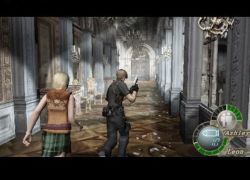 #9: Resident Evil 4 (PS2) - My #9 entry was also #10 on IGN's list. As much a third person shooter as it was a survival horror title, this game is widely acknowledged to have revitalized the Resident Evil franchise. I was initially disappointed that the game seemed to have done away with old-school zombies and the T virus in favor of crazy parasite-controlled villagers. I missed Umbrella as the main villain. But the series seems to have evolved beyond Umbrella. I'd also been initially annoyed with having to shoot with an analog stick, but I eventually got over that too. I'd planned to buy the PC version when it came out so that I could play with a mouse, but when it did come out, it had no mouse support. So I suppose the best version to get is the Nintendo Wii version, since aiming with the Wii Remote is the closest to a mouse you'll get.
#9: Resident Evil 4 (PS2) - My #9 entry was also #10 on IGN's list. As much a third person shooter as it was a survival horror title, this game is widely acknowledged to have revitalized the Resident Evil franchise. I was initially disappointed that the game seemed to have done away with old-school zombies and the T virus in favor of crazy parasite-controlled villagers. I missed Umbrella as the main villain. But the series seems to have evolved beyond Umbrella. I'd also been initially annoyed with having to shoot with an analog stick, but I eventually got over that too. I'd planned to buy the PC version when it came out so that I could play with a mouse, but when it did come out, it had no mouse support. So I suppose the best version to get is the Nintendo Wii version, since aiming with the Wii Remote is the closest to a mouse you'll get.
But enough with complaints - I'm supposed to be qualifying this as the tenth best game I've ever played. The story kept moving, and the battles were varied and exciting enough to keep me going even when they got really difficult. The atmosphere was possibly the best part - the European villages felt authentic, and the voices of the crazed villagers speaking in some obscure European language were likewise awesome.
The game had some downright amazing action sequences, including a chase on a jetski, a crazy battle against a sea monster where a harpoon was your only weapon, and a fight in which you needed to defend a distant companion with a sniper rifle. Of course, my favorite was the mine cart battle, in which you need to duck periodically or be clotheslined by passing beams.
Resident Evil 4 really is a tremendous game, and if you haven't yet played it, I suggest picking up a copy. You can read my full review here.
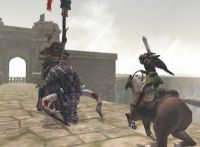 #8: The Legend of Zelda: Twilight Princess (Wii) - Although I haven't followed the Zelda franchise throughout the years, I picked this game up after having bought a Wii, and discovered in it all the things I like most about action adventure games. Twilight Princess really is one of the best games I've ever played.
#8: The Legend of Zelda: Twilight Princess (Wii) - Although I haven't followed the Zelda franchise throughout the years, I picked this game up after having bought a Wii, and discovered in it all the things I like most about action adventure games. Twilight Princess really is one of the best games I've ever played.
Part of the game's greatness comes from the variety in the scenery and in the gameplay. You visit deserts, snowy peaks, lava-filled mines, a city in the sky, and even a temple at the bottom of a lake. Each of these areas has its own unique challenges: in knee-deep snow, you move slowly, making it difficult to fight. In the city in the sky or when you're nearby lava, you can easily fall to your death. Underwater, you're swimming rather than walking.
Mini-games also help add to the game's variety. You'll find yourself boating, herding goats, fishing, sumo wrestling, swimming, and snowboarding. You'll undertake archery challenges, flight minigames, and even a well-designed rhythm minigame. Twilight Princess does horseback riding better than Oblivion, wall-walking better than Prey, and even has a boss battle worthy of Shadow Of the Colossus.
Twilight Princess is a long, long game. Throughout the course of your playtime, you'll find that new shops open for business, bridges are built and destroyed, and even transitions from day to night are handled very smoothly - you can see sunrises and sunsets, and the music slowly changes from the nighttime theme to the daytime theme and vice versa.
While a sizable portion of Twilight Princess's story is linear, I find that I often prefer a linear storytelling style to sandbox games such as Oblivion and Grand Theft Auto. It allows for better storytelling.
I've heard some criticism of this game, in that it was originally intended as a GameCube game rather than a Wii game, but to me that detracts nothing from it. While the Wii controls for swinging a sword sometimes felt tacked on, the mechanics for aiming a bow or boomerang with the Wii remote give more accuracy than a thumb stick ever could.
Although I've repeated a lot of what was in my review here, you can check it out at this link.
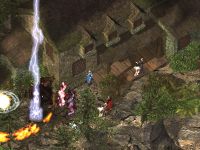 #7: Baldur's Gate II (PC) - I've been replaying this game for the past few months, and I am one hundred percent convinced that the Infinity Engine on which Baldur's Gate was based is the best video game RPG experience ever created. Wikipedia calls the Infinity Engine "the spiritual successor to the Gold Box Engine", in which Pool of Radiance was written. All I can say to that is that if they ever come out with a spiritual successor to The Infinity Engine, I'll have died and gone to heaven.
#7: Baldur's Gate II (PC) - I've been replaying this game for the past few months, and I am one hundred percent convinced that the Infinity Engine on which Baldur's Gate was based is the best video game RPG experience ever created. Wikipedia calls the Infinity Engine "the spiritual successor to the Gold Box Engine", in which Pool of Radiance was written. All I can say to that is that if they ever come out with a spiritual successor to The Infinity Engine, I'll have died and gone to heaven.
Baldur's Gate II allows you to control up to six characters of different classes in strategic pseudo-turn-based combat. You can have fighters rushing into combat while your thief hides and sneaks around back for a backstab and your spellcasters line up a lightning bolt. It's the strategic possibilities that really draw me into the game's combat. And this game has taken D&D to such high levels that your characters have use of spell sequencers, powerful magical artifacts, and must battle insanely powerful mages, vampires, and dragons. I love putting Web, Death Fog, and Ice Storm into a spell trigger and watching my trapped enemies flounder while I put arrows into them.
Baldurs Gate II added a lot that wasn't in the original game. In additon to the higher levels, it also added the barbarian, monk, sorcerer, and wild mage classes. My main character in my current play-through is a wild mage. His spells are unpredictable, but it's fun when you try to cast a stoneskin and instead find your skin changed to a bright orange color. The game also added a number of "kits" which specialize the old classes, adding and removing abilities. This makes for quite a lot of replayability. I'm sure that this replay of Baldur's Gate II will not be my last.
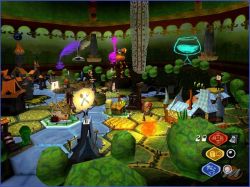 #6: Psychonauts (PC) - If anyone were to ask me what the funniest game I've ever played was, I wouldn't have to think very long before answering Psychonauts. It's the only game at which I've ever laughed out loud, and I did so more than once.
#6: Psychonauts (PC) - If anyone were to ask me what the funniest game I've ever played was, I wouldn't have to think very long before answering Psychonauts. It's the only game at which I've ever laughed out loud, and I did so more than once.
In Psychonauts, you play a boy named Rasputin who has run away from (not to) the circus, and sneaks into a summer camp for psychics. Of course, when the camp councelors catch him, they call his parents to come get him, but it's going to be a day or two before they arrive, so Rasputin has some time to spend at the camp, and he's determined to gain all his psychic merit badges in that time. Soon, he uncovers a nefarious plot.
When I first reviewed this game , I had a lot of complaints, but for some reason when I replayed the game a second time, I enjoyed it much more. The game has so many memorable moments, and I challenge anyone to play through Lungfishopolis and not enjoy the experience. The writing is downright amazing. If they make more games like this, video games will lose their bad name.
 #5: Starcraft (PC) - Ask most gamers what the best RTS game ever created is, and they'll answer Starcraft. IGN placed it 11th on their list, but I think it deserves a better spot. The game is nearing the end of its first decade on shelves, and every time I visit a store with PC games on the shelves, I still see the Starcraft Battle Chest for sale. It has held up unbelievably well, and is as popular in South Korea as baseball is in the United States.
#5: Starcraft (PC) - Ask most gamers what the best RTS game ever created is, and they'll answer Starcraft. IGN placed it 11th on their list, but I think it deserves a better spot. The game is nearing the end of its first decade on shelves, and every time I visit a store with PC games on the shelves, I still see the Starcraft Battle Chest for sale. It has held up unbelievably well, and is as popular in South Korea as baseball is in the United States.
There had been many real time strategy games before, but often the different competing factions were identical except for their appearance. This made balancing the different sides easy. The genius of Starcraft is that the factions are drastically different, yet perfectly balanced. And there are not two, but three perfectly balanced yet completely different sides.
The Terrans are essentially humans. They collect resources with SCVs, essentially men in robotic suits. The SCVs can also repair buildings and mechanical units such as tanks and battleships, which is a big advantage for Terrans. Terran buildings create SCVs as well as soldiers and vehicles, and even the buildings themselves are mobile - they can detach from the surface, lift off, and move to another location.
The Zerg are a monstrous race of insect-like creatures with a hive mind. Their units are generally built faster, and their strategies often include speed. They collect resources with drones that spawn out of the hive. Instead of a structure creating units, the drones themselves metamorphose into new units and living strutures, so a constant stream of new drones becomes necessary. Additionally, zerg structures must be built on "The Creep", a disgusting substance that grows along the ground near zerg areas, and expands as they do. Zerg units cannot be repaired, but will regenerate slowly while on the Creep.
Lastly, the Protoss. They are an advanced psychic race with powerful but expensive units. The Protoss use drone robots to collect resources, and these drones are also able to teleport in new structures rather than taking the time to build them. However, Protoss structures take their power from energy pylons, and a Protoss structure must be within the energy radius of a pylon or it will not function. All Protoss units and structures have energy shielding. A unit will not be damaged until its shields are gone. And while shields will regenerate, damaged Protoss units and structures cannot be healed or repaired.
That should give you just a hint of the complex balance in Starcraft. Serious skill is required at high levels of play, but for the single player campaign you can be as bad as I am and still do well. Starcraft 2 has been announced, and is one of my most-looked-forward to games right now. I've also just learned of the existance of two Starcraft expansions I hadn't known existed: Starcraft: Insurrection and Starcraft: Retribution. I'll have to try to get copies somewhere.
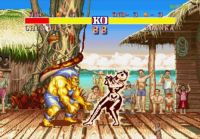 #4: Street Fighter 2 (Arcade) - While some merely refer to Street Fighter 2 as the beginning of the Fighter game genre, I believe it's the finest fighting game ever created. It's listed as the penultimate fighting game in the GamerHelp article Games That Define their Genres.
#4: Street Fighter 2 (Arcade) - While some merely refer to Street Fighter 2 as the beginning of the Fighter game genre, I believe it's the finest fighting game ever created. It's listed as the penultimate fighting game in the GamerHelp article Games That Define their Genres.
It was probably 1990 when I first discovered the game with my friend Rodney. It was he who first discovered that Ryu and Ken could actually shoot fireballs out of their hands if you did something special with the joystick. But those gestures remained mysteries for at least a year, and I had to settle with keeping people at a distance with Dhalsim and using E.Honda's Hundred Hand Slap. Eventually, I learned the mysteries of the fireball and the flash kick. And when I ended up working at an arcade between 1992 and 1996, I got the chance to master it. I stayed with the game through Champion Edition, Turbo Edition, and Super Street Fighter 2. I played at college where people would line up their quarters on the game's marquee, queueing themselves to play. I learned to deal with turtlers and jab-throwers. I saw the game in my sleep. Eventually, I was as good at the game as pretty much anyone else I ever met, and better than most. And it was good.
It's probably my favorite arcade game of all time, barely edging out Dance Dance Revolution. There is a subtlety and skill to the game that few ever understand and even fewer master. Since Street Fighter II, many other games have come out with better graphics, higher-hitting combos, and more characters to choose from, but in the days when three-hit-combos were difficult and four-hit combos were really damn impressive, Street Fighter II was king. And every game since has just built on the formula that Street Fighter II created.
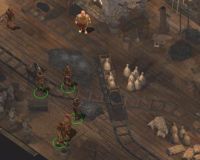 #3: Baldur's Gate (PC) - Yes, I'm listing both games in the series amongst my top ten. But while Baldur's Gate 2 was amazing in its higher resolutions, bigger badder monsters, and increased class and spell lists, the original Baldur's gate is still slightly superior.
#3: Baldur's Gate (PC) - Yes, I'm listing both games in the series amongst my top ten. But while Baldur's Gate 2 was amazing in its higher resolutions, bigger badder monsters, and increased class and spell lists, the original Baldur's gate is still slightly superior.
Why? It's a bit difficult to put my finger on. I enjoyed the storyline and revelations of the first more than I did the second, plus I've always enjoyed adventuring with lower level characters. The complexity of the sequel actually at times became a bit of a chore and a detriment, whereas the original Baldurs Gate was just plain fun.
Baldur's Gate was the first game to introduce us to the Infinity Engine and its amazing psuedo-turn based style and multiplayer capabilities. To this date, ten years later, it's the best RPG available.
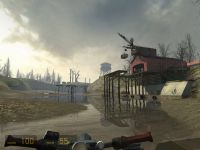 #2: Half-Life 2 and its episodes (PC) - Not only was Half-Life 2 the game that made me start enjoying first person shooters, it has remained the best first person shooter in existance to this day. Every aspect of the game is top-notch, from the storyline to the graphics to the physics.
#2: Half-Life 2 and its episodes (PC) - Not only was Half-Life 2 the game that made me start enjoying first person shooters, it has remained the best first person shooter in existance to this day. Every aspect of the game is top-notch, from the storyline to the graphics to the physics.
I'm a big fan of good science fiction, and a sucker for alien invasion stories. So this one grabbed me right away. In the first game, alien monsters appeared as part of an interdimensional accident at the top secret Black Mesa science facility. In this sequel, you learn that it was all part of a planned invasion. The Combine has taken over, and is using genetically modified humans as its police force. Your character, Gordon Freeman, ends up leading the rebellion. The setting, the details, and the atmosphere are amazing.
Half-Life 2 is years old now, but it's still the game I always look back to when comparing graphics. On my machine, Bioshock looked good, but not better than Half-Life 2, and Bioshock had a horrible framerate. I'm sure that with a better graphics card Bioshock looks and runs better, but why could they not achieve similar graphics with a similar performance when the settings were lowered? Half-Life 2 runs amazingly smoothly on my machine.
Half-Life 2 also introduced what is still the best physics engine out there. The Source Engine is amazing. When I first started playing the game, I had fun in an alley just picking up glass bottles, throwing them against a wall and watching them break. Later, I had fun pushing cars over cliffs. In the game, I mean.
Episodes 1 and 2 were the expansions to Half-Life 2, and they only made the whole thing better. In Episode 1, the NPC Alyx Vance accompanied you most of the way, and Valve's designers did some amazing things with her - having her grapple wih zombies and step on antlions. She'd squint and put her hand up when you shined the flashlight in her face, and she displayed emotion more than any other game I've ever seen, through a combination of facial expression and amazing voice acting. They also added a good bit of humor, which I won't spoil.
Episode 2 upped the ante even further, adding more jokes and even higher production quality. The story progresses quite a bit, and the ending is the only portion of a video game that has ever made me want to cry. Honestly.
IGN placed this game #6 on their list, but I think that's too low. I struggled for a long time over whether this game would be #2 or #1, and it was very close.
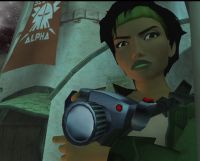 #1: Beyond Good and Evil (PC) - After a lot of thought, I've got to say that this is my favorite game of all time. Its storyline, the variety of gameplay, and the excellent implementation of cinematic and stealth elements combine to form a stellar game that I've already replayed twice.
#1: Beyond Good and Evil (PC) - After a lot of thought, I've got to say that this is my favorite game of all time. Its storyline, the variety of gameplay, and the excellent implementation of cinematic and stealth elements combine to form a stellar game that I've already replayed twice.
First of all, don't try to derive any meaning from the name, because there is none. It's just a catch phrase with no relevance. In Beyond Good and Evil, you play the part of Jade, a young female photographer on a planet called Hillys. Hillys is a futuristic society plagued by invasions from a race of alien abductors called the DomZ. (pronounced doms) Hillys itself is populated not only by humans, but by other races that have evolved not only from apes, but from goats, rhinos, sharks, and many other animals. It's a bit odd at first, but you get used to it. Jade lives in a lighthouse/orphanage with the kindly pig-man who raised her, where Jade struggles to earn enough money from her photography to pay the power bill for the energy shield that protects them from the DomZ.
The story moves on as Jade discovers a conspiracy and works to gain photographic evidence, which she plans to publish in an underground newspaper to win over the hearts and minds of the citizens of Hillys.
The variety of gameplay here is one of the things that won me over with this game. Like Twilight Princess, Beyond Good and Evil has battles, puzzles, minigames, side quests, collection, and first-person target practice. But it's got a lot more. Vehicle driving, picture-taking, and some of the best stealth gameplay I've ever seen in any game. Of course, some of the most difficult areas in the game are optional, which is good for people who get frustrated with it, but I'm all about trying those areas ten times until I get them right, because they're so damn fun.
If you've never played this game, you need to. Pick it up for PC, XBox, or Playstation 2.
It looks like that wraps up my list. I haven't seen a lot of comments on these, so please - comment with your favorite games, or comment on games that I've listen or games I've missed. I'm interested in a discussion.